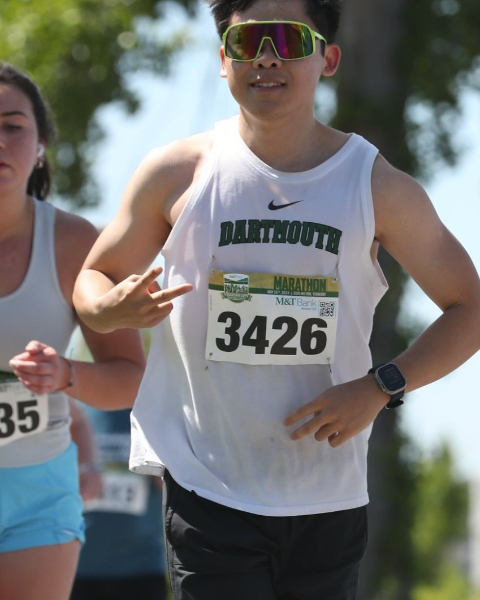QP 17 - Phys 10: Imaging for Treatment Monitoring
1098 - Quantification of Local-Regional Deformation Based on Cherenkov Imaged Vasculature for Breast Radiotherapy Patients
Tuesday, October 1, 2024
5:35 PM - 5:40 PM ET
Location: Room 147

Yao Chen, BS
Dartmouth College
Hanover, NH
Presenter(s)
Y. Chen1, S. M. Decker1, P. Bruza1, L. A. Jarvis2,3, D. J. Gladstone1,4, B. W. Pogue5, K. S. Samkoe1,4, and R. Zhang1,4; 1Thayer School of Engineering, Dartmouth College, Hanover, NH, 2Geisel School of Medicine, Dartmouth College, Hanover, NH, 3Department of Radiation Oncology and Applied Sciences, Dartmouth Cancer Center, Dartmouth Health, Lebanon, NH, 4Dartmouth Cancer Center, Dartmouth Health, Lebanon, NH, 5University of Wisconsin-Madison, Madison, WI
Purpose/Objective(s): Variations in patient positioning can profoundly influence treatment outcomes, so accurate positioning is crucial for precise radiotherapy dose delivery. This study introduces a novel application of Cherenkov imaging and hypothesizes that it allows for the precise quantification of local-regional tissue deformations to improve the accuracy of patient positioning in breast cancer radiotherapy. For the first time, local-regional deformation is quantified based on Cherenkov imaged vasculature, opening a new avenue to improve the precision of patient positioning. Materials/
Methods: Optical attenuation by blood provides sufficient contrast between vasculature and surrounding tissues. After segmenting blood vessels within Cherenkov images as patient-specific biological fiducial markers, a rigid and non-rigid combined registration was deployed to quantify both inter- and intra-fraction positioning accuracy. The submillimeter accuracy was validated by imaging an anthropomorphic chest phantom with similar human vasculature during a simulated breast radiotherapy treatment, whereas the inter- and intra-fraction variations were simulated by couch shifts and respiratory motion. For 10 patients, 2D maps of local-regional tissue deformations based on non-rigid registration followed by a global shift based on a rigid registration has been quantified in the treatment region for the first time.
Results: The accuracy was validated to be within 0.83 ± 0.49 mm for the simulated inter- and intra-fraction variations. A paired t-test revealed no significant difference between the simulated and quantified variations. (P value = 0.2883 > 0.05). A retrospective Cherenkov imaging dataset including 10 breast cancer patients was analyzed for patient positioning variations within their treatment course, revealing an inter-fraction setup uncertainty of 3.71 ± 2.36 mm. Quantitative 2D deformation maps per fraction indicated local-regional deformation in addition to conventional global shifts. Much fewer deformations of 0.0487 ± 0.0385 mm quantified by the non-rigid registration performed after the rigid registration was observed compared to the rigid shift of 3.66 ± 2.35 mm in a paired t-test (P value < 0.0001), which indicates rigid registration captured the majority of global variations, with non-rigid registration addressing the residual local deformations.
Conclusion: This study reports the first directly observed local-regional deformation and a method to precisely quantify the global and local variations in patient positioning based on rigid and non-rigid registrations using Cherenkov imaged vasculature. This novel approach demonstrates the feasibility of providing real-time quantitative imaging guidance to inform inter- and intra-fraction positioning, enhancing the precision of breast cancer radiotherapy.
Purpose/Objective(s): Variations in patient positioning can profoundly influence treatment outcomes, so accurate positioning is crucial for precise radiotherapy dose delivery. This study introduces a novel application of Cherenkov imaging and hypothesizes that it allows for the precise quantification of local-regional tissue deformations to improve the accuracy of patient positioning in breast cancer radiotherapy. For the first time, local-regional deformation is quantified based on Cherenkov imaged vasculature, opening a new avenue to improve the precision of patient positioning. Materials/
Methods: Optical attenuation by blood provides sufficient contrast between vasculature and surrounding tissues. After segmenting blood vessels within Cherenkov images as patient-specific biological fiducial markers, a rigid and non-rigid combined registration was deployed to quantify both inter- and intra-fraction positioning accuracy. The submillimeter accuracy was validated by imaging an anthropomorphic chest phantom with similar human vasculature during a simulated breast radiotherapy treatment, whereas the inter- and intra-fraction variations were simulated by couch shifts and respiratory motion. For 10 patients, 2D maps of local-regional tissue deformations based on non-rigid registration followed by a global shift based on a rigid registration has been quantified in the treatment region for the first time.
Results: The accuracy was validated to be within 0.83 ± 0.49 mm for the simulated inter- and intra-fraction variations. A paired t-test revealed no significant difference between the simulated and quantified variations. (P value = 0.2883 > 0.05). A retrospective Cherenkov imaging dataset including 10 breast cancer patients was analyzed for patient positioning variations within their treatment course, revealing an inter-fraction setup uncertainty of 3.71 ± 2.36 mm. Quantitative 2D deformation maps per fraction indicated local-regional deformation in addition to conventional global shifts. Much fewer deformations of 0.0487 ± 0.0385 mm quantified by the non-rigid registration performed after the rigid registration was observed compared to the rigid shift of 3.66 ± 2.35 mm in a paired t-test (P value < 0.0001), which indicates rigid registration captured the majority of global variations, with non-rigid registration addressing the residual local deformations.
Conclusion: This study reports the first directly observed local-regional deformation and a method to precisely quantify the global and local variations in patient positioning based on rigid and non-rigid registrations using Cherenkov imaged vasculature. This novel approach demonstrates the feasibility of providing real-time quantitative imaging guidance to inform inter- and intra-fraction positioning, enhancing the precision of breast cancer radiotherapy.
